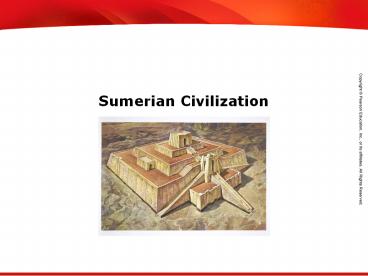Sumerian Civilization PowerPoint PPT Presentation
1 / 15
Title: Sumerian Civilization
1
Sumerian Civilization
2
Objectives
- Understand how geography influenced the
development of civilization in the Fertile
Crescent. - Outline the main features of Sumerian
civilization. - Explain how the advances in learning made by the
Sumerians left a lasting legacy for later people
to build on.
3
Terms and People
- Fertile Crescent a region of the Middle East
where civilization first arose - Sumer region where the worlds first
civilization arose around 3300 B.C. - Mesopotamia an area between the Tigris and
Euphrates rivers where the civilization of Sumer
arose - The Epic of Gilgamesh a Sumerian narrative poem
that includes a story about a flood that destroys
the world
4
Terms and People (continued)
- hierarchy a system of social ranking
- ziggurat in ancient Mesopotamia, a large
stepped platform thought to have been topped by a
temple dedicated to a citys chief god or goddess - cuneiform the earliest known form of writing
used a series of wedge-shaped marks on clay
tablets
5
What were the characteristics of the worlds
first civilization?
A number of early civilizations arose in
southwestern Asia, in the Fertile Crescent. The
worlds first civilization was Sumer. Over time,
nomadic herders, invaders, and traders easily
overcame the regions few natural barriers. As a
result, the region became a crossroads for people
and ideas. Each new group that arrived made its
own contributions to the history of the region.
6
The Greeks called the land between the Tigris and
Euphrates rivers Mesopotamia, meaning between
the rivers. The city-states of Sumer developed
in southeastern Mesopotamia around 3300 B.C.
7
To survive frequent floods and provide
irrigation, temple priests and royal officials
organized villagers to build canals and dikes.
Control of the Tigris and Euphrates rivers was
key to the development of Mesopotamia.
A Sumerian narrative poem, The Epic of Gilgamesh,
described a flood that destroys the world.
8
- Ur and Uruk, two of the worlds first great
cities, were built of dried clay bricks. - Sumerians traded for needed goods from as far
away as Egypt and India.
Sumerians lacked timber, stone, and many other
resources.
Scholars believe that the first wheeled vehicles
were used in Sumer.
9
Sumer included a dozen separate city-states. For
protection, people turned to war leaders, who
evolved into hereditary rulers.
A complex government unfolded
Rulers in each city-state kept up city walls
and irrigation systems.
They led armies, enforced laws, and employed
scribes, who collected taxes and kept records.
The ruler was chief servant of the gods and led
religious ceremonies.
10
Sumerian society was highly structured. Each
city-state had a hierarchy, a system for ranking
groups of people.
Women lacked legal equality, but some were
educated and Sumerians honored some goddesses.
11
To ensure the safety of their city-state,
Sumerians believed it was their responsibility to
keep their deities happy.
Each city built a ziggurat, a large stepped
platform topped by a temple. Holy days were
celebrated with ceremonies and processions for
the gods and goddesses.
Sumerians believed in a grim afterlife.
12
The Sumerians developed cuneiform, the earliest
known writing system.
- Cuneiform consisted of wedge-shaped symbols
marked in clay. - It developed from a system of pictographs that
recorded goods brought to temple storehouses. - Later, scribes recorded myths, prayers, and laws.
13
Cuneiform evolved over time.
8,000 B.C. Shaped clay tokens were used to
record items of exchange.
3,500 B.C. Tokens were pressed into clay tablets
to make signs or pictographs.
3,200 B.C. A true writing system developed,
including symbols for words and syllables.
14
Sumerian scholars made advances in astronomy and
mathematics.
- They recorded the movements of planets and
stars. - They created a number system based on six.
Later peoples, such as the Babylonians, Greeks,
and Romans, all built on Sumerian knowledge.
15
Between 2500 B.C. and 1900 B.C., invading armies
conquered the city-states of Sumer. As a result,
Sumerian civilization spread.
Sumers legacy
A counting system based on the number six, still
used to tell time (60 minutes) and to measure a
circle (360 degrees).
The Epic of Gilgamesh has been translated and
passed down to today.
Other civilizations adoptedand revised cuneiform.

